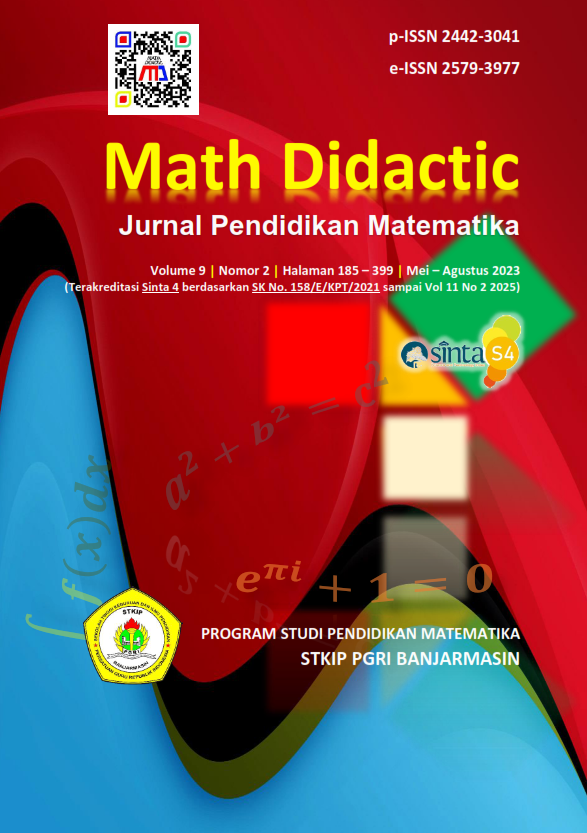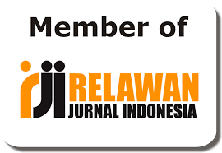Student’s learning obstacles in statistics materials related to computational thinking skills
Learning obstacle siswa dalam materi statistika terkait dengan kemampuan computational thinking
Abstrak
The inclusion of computational thinking skills into the PISA assessment is a new challenge for Indonesian students. One of the most important roles in process of problem solving has not been widely applied by students due to learning obstacle. This study was qualitative research with a phenomenological approach to identify the learning obstacles of junior high school students in statistics material related to computational thinking skills. The research instruments used were test computational thinking skills and interview guidelines. The data obtained from the test results of 17 students from one of junior high schools in Garut, were analyzed through the stages of data reduction, data presentation and drawing conclusions. The results showed that students experienced three types of learning obstacles in statistic material related to computational thinking skills, namely: epistemological obstacle, ontogenic obstacle, and didactical obstacle.
##plugins.generic.usageStats.downloads##
Referensi
Angeli, C., & Giannakos, M. (2020). Computational thinking education: Issues and challenges. Computers in Human Behavior, 105, 106185. https://doi.org/https://doi.org/10.1016/j.chb.2019.106185
Angeli, C., Voogt, J., Fluck, A., Webb, M., Cox, M., Malyn-Smith, J., & Zagami, J. (2016). A K-6 computational thinking curriculum framework: Implications for teacher knowledge. Educational Technology and Society, 19(3), 47–57.
Barr, V., & Stephenson, C. (2011). Bringing computational thinking to K-12: What is involved and what is the role of the computer science education community? ACM Inroads, 2(1), 48–54. https://doi.org/10.1145/1929887.1929905
Brousseau, G. (2002). Theory of Didactical Situations in Math- ematics. Kluwer Academic Publishers.
Dewi, D. K., Khodijah, S. S., & Zanthy, L. S. (2020). Analisis Kesulitan Matematik Siswa SMP pada Materi Statistika. Jurnal Cendekia : Jurnal Pendidikan Matematika, 4(1), 1–7. https://doi.org/10.31004/cendekia.v4i1.148
Fauji, T., Sampoerna, P. D., & Hakim, L. El. (2022). Penilaian Berpikir Komputasi Sebagai Kecakapan Baru dalam Literasi Matematik. Prosiding Seminar Nasional Fakultas Tarbiyah Dan Keguruan Universitas Negeri Alauddin Makasar, 598–514.
Hariyomurti, B., Prabawanto, S., & Jupri, A. (2020). Learning Obstacle Siswa dalam Pembelajaran Barisan dan Deret Aritmetika. Juring (Journal for Research in Mathematicas Learning), 3(3), 283–292.
Henderson, P. B., Cortina, T. J., & Wing, J. M. (2007). Computational Thinking. SIGCSE Bull., 39(1), 195–196. https://doi.org/10.1145/1227504.1227378
Maarif, S., Perbowo, K. S., Noto, M. S., & Harisman, Y. (2019). Obstacles in Constructing Geometrical Proofs of Mathematics-Teacher-Students Based on Boero’s Proving Model. Journal of Physics: Conference Series, 1315(1), 12043. https://doi.org/10.1088/1742-6596/1315/1/012043
Mohaghegh, M., & McCauley, M. (2016). Computational Thinking: The Skill Set of the 21st Century. International Journal of Computer Science and Information Technologies, 7(3), 1524–1530.
OECD. (2019). Programme for International Student Assessment (PISA) Results from PISA 2018. In OECD Publishing. https://doi.org/10.1007/978-94-6209-497-0_69
OECD, O. for E. C. and D. (2021). OECD member countries and Associates decided to postpone the PISA 2021 assessment to 2022 to reflect post-Covid difficulties. This draft vision was created before the crisis. The final version will reflect the new name of the cycle “PISA 2022.” 95.
Rahmah, B. N., & Maarif, S. (2021). Analisis Epistimologi Obstacles Terhadap Siswa Smp Kelas Vii Dengan Materi Statistika (Penyajian Data). Jurnal Matematika UNAND, 10(4), 510. https://doi.org/10.25077/jmu.10.4.510-518.2021
Rahman, H. (2017). Analisis Learning Obstacles yang Dialami Siswa pada Materi Penyajian Data Berdasarkan Perspektif Standar Tes PISA Konten Uncertainty and Data (Universitas Pendidikan Indonesia). Retrieved from http://repository.upi.edu/id/eprint/32262%0Ahttp://repository.upi.edu/32262/10/T_MTK_1502470_Bibliography.pdf
Rosali, D. F. (2022). Learning Obstacles Siswa SMP dalam Berpikir Komputasi pada Materi Pola Bilangan (Universitas Pendidikan Indonesia). Retrieved from http://repository.upi.edu/71191/
Sudrajat. (2008). Ilmu Pengetahuan dan Teknologi. “The Power of Mathematics for All Aplications,” 1–12.
Sumarni, & Adiastuty, N. (2015). Perbandingan Pemahaman Matematis Antara Siswa Yang Memperoleh Pembelajaran Metode Discovery Dan Metode Advance organizer. Euclid, Vol. 2, pp. 226–237.
Sumarni, Darhim, & Fatimah, S. (2021). Kemampuan pemecahan masalah mahasiswa calon guru matematika sekolah menengah berdasarkan tahapan polya. AKSIOMA: Jurnal Program Studi Pendidikan Matematika, 10(3), 1396–1411.
Sumarni, S., Darhim, D., Fatimah, S., Priatna, N., Anjelita, A., & Taufik, A. (2018). The students’ mathematical concept understanding ability through cooperative learning type jigsaw assisted visual media. Journal of Physics: Conference Series, 1132(1). https://doi.org/10.1088/1742-6596/1132/1/012051
Supiarmo, G., Turmudi, T., & Susanti, E. (2021). Proses Berpikir Komputasional Siswa Dalam Menyelesaikan Soal Pisa Konten Change and Relationship Berdasarkan Self-Regulated Learning. Numeracy, 8(1), 58–72. https://doi.org/10.46244/numeracy.v8i1.1378
Suryadi, D. (2011). Didactical Design Research (DDR) dalam Pengembangan Pembelajaran Matematika. Joint-Conference UPI-UTiM. (April).
Tsao, Y.-L. (2006). Teaching Statistics With Constructivist-Based Learning Method To Describe Student Attitudes Toward Statistics. Journal of College Teaching & Learning (TLC), 3(4), 59–64. https://doi.org/10.19030/tlc.v3i4.1728
Weintrop, D., Beheshti, E., Horn, M. S., Orton, K., Jona, K., Trouille, L., & Wilensky, U. (2016). Defining Computational Thinking for Mathematics and Science Classrooms. Journal of Science Education and Technology, 25, 127–147.
Wing, J. M. (2006). Computational thinking. Communications of the ACM, Vol. 49, pp. 33–35. https://doi.org/10.1145/1118178.1118215
Yusuf, Y., Titat, N., & Yuliawati, T. (2017). Analisis Hambatan Belajar (Learning Obstacle) Siswa SMP Pada Materi Statistika. Aksioma, 8(1), 76. https://doi.org/10.26877/aks.v8i1.1509






















